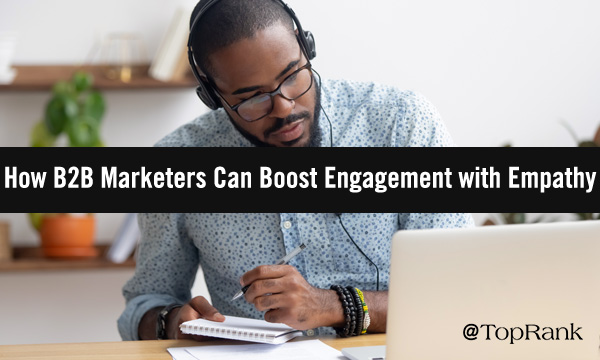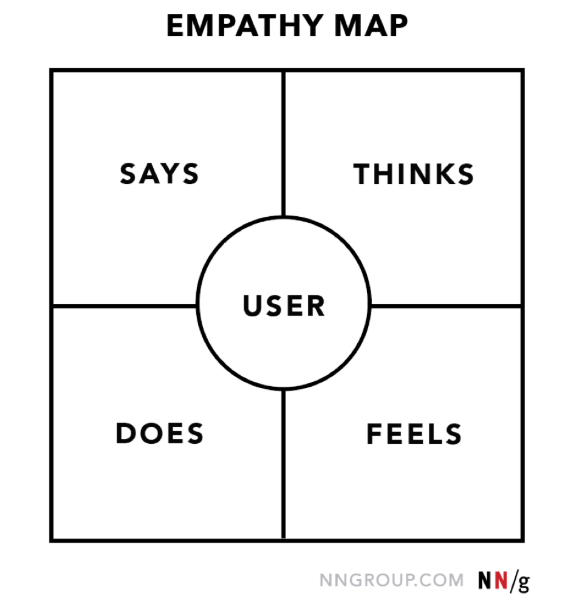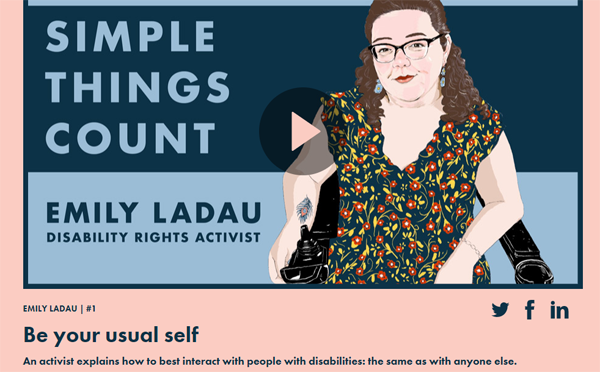Boosting and Deepening Engagement through Empathy in B2B Marketing


Empathy is more than a buzzword. It’s not a box to be checked, or an added finishing touch for content. If B2B marketers want to successfully engage human audiences and break free from the deluge of irrelevant messages swirling around today’s customers, empathy needs to be at the center of all strategic initiatives from start to finish.
What Does Empathy Mean in B2B Marketing?
Empathy is defined simply as the ability to understand and share the feelings of another. But I’m not sure that characterization fully does it justice in the context of modern marketing.
I rather like the way Zen Media CEO Shama Hyder described empathy in the better creative teamwork guide we helped our clients at monday.com put together:
“Empathy is critical. It’s much more than just having an understanding of what someone else’s challenges might be. Part of it is that you have to give up being a control freak. As leaders, we should really look at the big picture and ask ourselves, is this necessary? Or is this just politicking, or someone trying to make it seem like it has to be done this way because it’s the way they prefer?”
Shama was speaking from the perspective of a business leader trying to get on the same page as their team, but it applies just as well to marketing endeavors. The critical first step in developing empathy is disconnecting from our own ingrained perceptions and assumptions. Only then can we truly understand and support the audiences we want to reach.
Too often, empathy in marketing tends to be a bit narrow and self-centered (which is contradictory to the very concept itself). We often seek to understand only the challenges and pain points that drive interest in what we’re selling. Looking beyond this scope is necessary to build strong relationships founded on trust, especially now.
“What you are creating, marketing and ultimately selling is but one piece of your customer’s life as a human on Earth. One very small piece,” said Mary Beech, principal at MRB Brand Consulting and former CMO of Kate Spade, in an AMA article on empathy in marketing. “And if we aren’t keeping in mind their full journey, including their emotional, mental, social and physical needs — as well as the challenges and joys they are facing — we cannot do our jobs well.”
As Brian Solis wrote at Forbes recently, the need for empathetic customer experiences is greater than ever in the age of COVID-19 disruption. People have so much going on in their lives, and are facing so many unprecedented difficulties, that a myopic brand-centric focus is all the more untenable. “Traditional marketing will no longer have the same effect moving forward,” he argues. “If anything, it will negatively affect customer relationships rather than enhance them.”
Agreed. So, let’s find a better way.
Engaging with True Empathy in the New Era of Marketing
Imagine if it was possible to sit down and have an in-depth conversation with each one of your customers and potential customers. You’d gain first-hand insight into their worldviews, their challenges, their hopes and dreams.
Sadly, it’s not possible. You don’t have the time, nor do your customers. (Although I do recommend making a habit of engaging in direct, candid conversations with them when possible.) To make empathy scalable, marketers need to take advantage of all the tools at their disposal. This largely requires using data to connect the dots.
“It’s critical for marketers to have a real-time 360 view and understanding of a customer’s full journey, at every stage, from discovery to engagement to retention and loyalty to advocacy,” Solis wrote at Forbes.
Here are some suggestions for obtaining such a view:
Use empathy-mapping. This practice, explained in a helpful primer from Nielsen Norman Group, involves creating a visualization of attitudes and behaviors to guide decision-making. Empathy-mapping originated in the world of UX design, but given how much user experience and customer experience now overlap, it’s becoming a powerful tool for marketers.

(Source: Nielsen Norman Group)
Coordinate and integrate your organizational efforts. Every customer-facing function in a company — marketing, sales, customer service — sees the customer from a different perspective. Seek ways to bring all these perspectives together into one centralized, holistic view. Per Solis: “Cross-functional collaboration is a mandate. As such, integration will become the new standard and will quickly become table stakes as every company rushes in this direction.”
Tap into meaningful influencer relationships. Influencers can play a key role in empathetic marketing because they have relationships and perspectives extending beyond our brand ecosystems. If they align with your audience, influencers can bring unique insight and connect at deeper levels. Turning influencer engagements from mechanical to meaningful is essential to accomplishing this.
Incidentally, Mr. Solis recently partnered with TopRank Marketing on the first-ever State of B2B Influencer Marketing report, in which our friend Ann Handley summarizes the impact quite well: “You could call yourself a good parent or a world-class marketer or an empathetic friend … but any of those things would carry more weight coming from your child, customer, or BFF. So it is with integrating influencer content: It’s a direct line to building trust and customer confidence.”
Research and engage with topics that matter to your customers outside of their jobs. Given the connotations of B2B, it’s all too easy to isolate our customer research around what they do professionally. But these are human beings with lives outside of work. To drive powerful engagement, marketers should search for the cross-sections between their brand’s purpose and values, and what matters to their customers.
A good example of this is found in the IBM THINK Blog, which is “dedicated to chronicling the fast-moving world of cognitive computing” and covers many important societal topics. (Recent focuses include a post on gender pronouns and a corporate environmental report.)
Examples of Empathetic B2B Marketing
Who’s getting it right and paving the way for a more empathy-driven approach to engaging B2B audiences? Here are a few examples:
- My post on seven B2B brands that talk to consumers, not companies highlights several instances of an authentic and relatable human tone shining through.
- It goes without saying that the video-conferencing service Zoom stumbled into a massive business opportunity with the dramatic pivot to remote work this year. The company could simply try to cash in and maximize that opportunity, but instead, they’re doubling down on building trust. Zoom’s CEO Eric S. Yuan recently wrote about his roots in China in articulating his organization’s support for this embattled region of the world, noting that Zoom is providing expanded features for free accounts and offering accessible resources and education. He also made the company’s tools free to K-12 schools (a potentially lucrative customer base) in March.
Seeing human faces brings an instantly relatable element to any B2B campaign. That’s why Microsoft’s Story Labs microsite, which frames some of the company’s initiatives and guiding principles around real people and their stories, is so effective.

Let Empathy Guide Your B2B Marketing Strategy
In order to walk in someone else’s shoes, you first need to untie and remove your own. Making empathy a core strategic pillar requires marketers to take a step back, disconnect from their ingrained perceptions and assumptions, and get fully in tune with the people they serve.
Only then can we create the type of relevant and personalized experiences that drive deep and long-lasting brand engagement.
For more tips that will help your business-oriented content strike notes of genuine empathy, read Josh Nite’s blog post on 5 Ways to Humanize B2B Marketing.
The post Boosting and Deepening Engagement through Empathy in B2B Marketing appeared first on Online Marketing Blog – TopRank®.